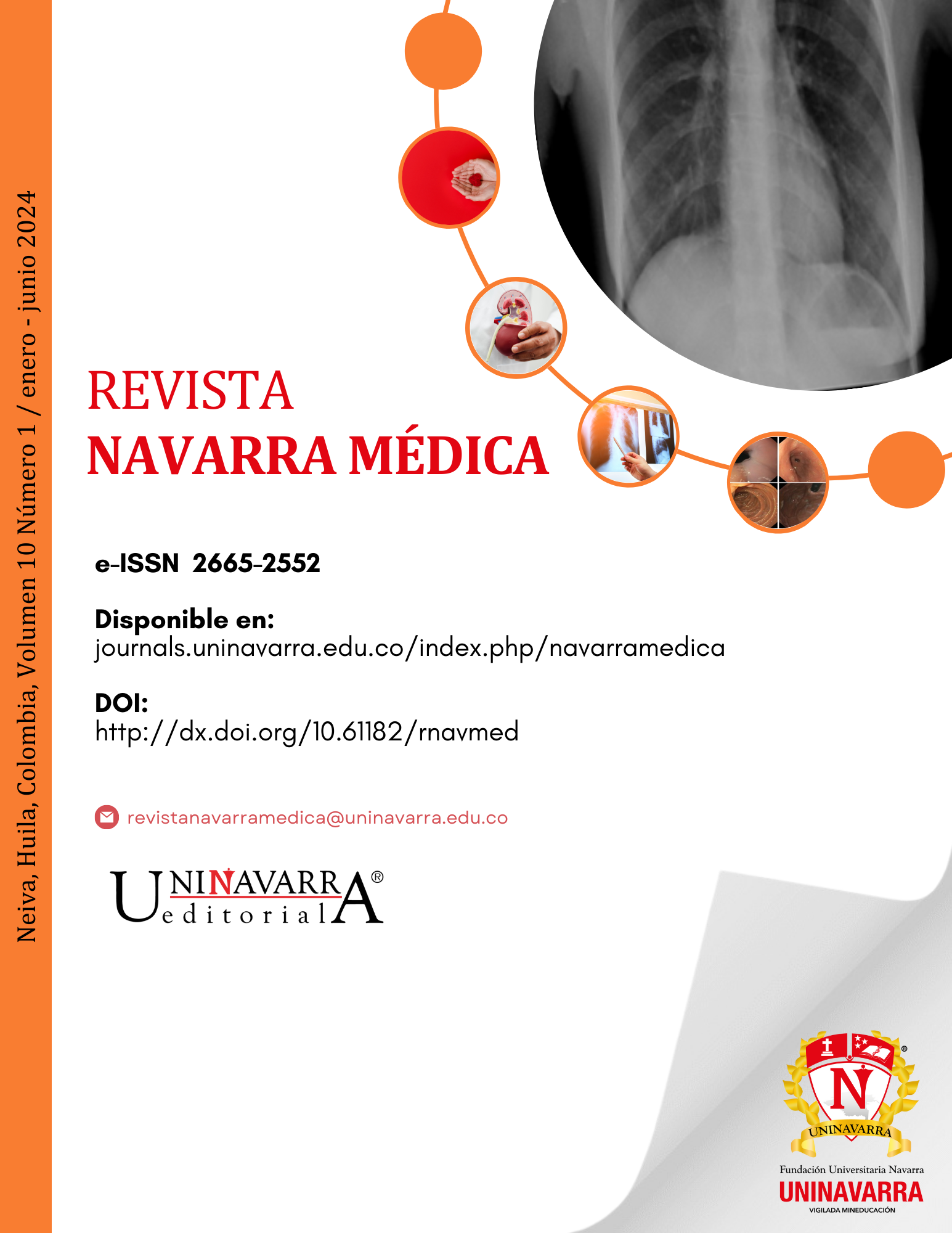Demographic characterization, risk factors and outcomes in patients with postpartum hemorrhage, 2016 - 2022 in a referral hospital in southern Colombia
DOI:
https://doi.org/10.61182/rnavmed.v10n1a1Keywords:
Postpartum hemorrhage, Risk Factors, Morbidity, HysterectomyAbstract
Objective: To present the demographic profile, the interventions applied and maternal outcomes in women who experienced postpartum hemorrhage in a medium complexity hospital in Neiva, Colombia.
Methods: A descriptive, cross-sectional, retrospective cohort study was conducted, involving 142 postpartum women with a diagnosis of postpartum hemorrhage, attended in a public health institution between January 2016 and December 2022. The sampling was non-probabilistic by convenience, and the information was obtained by reviewing clinical records as a secondary source.
Results: A considerable proportion of the patients (42%) were between 19 and 25 years old. Vaginal delivery was used in 59.7% of the cases. The main cause of postpartum hemorrhage was uterine atony, responsible for 65% of the cases. Red blood cell transfusion was required in 57% of the patients. Fifty-seven percent also required admission to an ICU; however, 35% were admitted because of the concomitant presence of severe preeclampsia, treated with magnesium sulfate, and all of them experienced PPH due to atony. Only 18% of cases required surgical intervention, and a total of 21 patients underwent hysterectomy, of whom 7 initially received conservative surgical management. No maternal mortality was reported.
Conclusions: uterine atony was the most common cause of postpartum hemorrhage; the main risk factors for an adverse outcome, such as hysterectomy, included placenta previa, placental accreta, and deliveries attended at that health care center.
References
(1) Say L, Chou D, Gemmill A, Tunçalp Ö, Moller AB, Daniels J, et al. Global causes of maternal death: A WHO systematic analysis. Lancet Glob Health. 2014;2 (6): e323-e333. http://dx.doi.org/10.1016/S2214-109X(14)70227-X
(2) Instituto Nacional de Salud. Boletín Epidemiológico de Salud. Semana epidemiológica 23. Colombia. 2019. https://www.ins.gov.co/buscador-eventos/BoletinEpidemiologico/2019%20Bolet%C3%ADn%20epidemiol%C3%B3gico%20semana%2023.pdf
(3) Pacagnella RC, Souza JP, Durocher J, Perel P, Blum J, Winikoff B, et al. A Systematic Review of the Relationship between Blood Loss and Clinical Signs. PLoS One. 2013 Jun; 8(3):e57594. https://doi.org/10.1371%2Fjournal.pone.0057594
(4) Postpartum Hemorrhage ACOG PRACTICE BULLET IN Clinical Management Guidelines for Obstetrician-Gynecologists [Internet]. 2017. Available from: http://www1.health.nsw.gov.au/pds/ActivePDSDocuments/
(5) Bienstock JL, Eke AC, Hueppchen NA. Postpartum Hemorrhage. Longo DL, editor. New England Journal of Medicine [Internet]. 2021 Apr 29;384(17):1635–45. Available from: http://www.nejm.org/doi/10.1056/NEJMra1513247
(6) Escobar MF, Nassar AH, Theron G, Barnea ER, Nicholson W, Ramasauskaite D, et al. FIGO recommendations on the management of postpartum hemorrhage 2022. International Journal of Gynecology and Obstetrics. 2022 Mar 1;157(S1):3–50. https://doi.org/10.1002/ijgo.14116
(7) Anderson JM, Etches D. Prevention and management of postpartum hemorrhage. Vol. 75, American Family Physician. 2007. p. 875–82. https://pubmed.ncbi.nlm.nih.gov/17390600/
(8) Robinson D, Basso M, Chan C, Duckitt K, Lett R. Guideline No. 431: Postpartum Hemorrhage and Hemorrhagic Shock. Journal of Obstetrics and Gynaecology Canada. 2022 Dec 1;44(12):1293-1310.e1. https://doi.org/10.1016/j.jogc.2022.10.002
(9) Postpartum Hemorrhage ACOG PRACTICE BULLET IN Clinical Management Guidelines for Obstetrician-Gynecologists [Internet]. 2017. Available from: http://www1.health.nsw.gov.au/pds/ActivePDSDocuments/
(10) Ruysen H, Shabani J, Hanson C, Day LT, Pembe AB, Peven K, et al. Uterotonics for prevention of postpartum haemorrhage: EN-BIRTH multi-country validation study. BMC Pregnancy Childbirth. 2021 Mar 1;21. https://doi.org/10.1186/s12884-020-03420-x
(11) Bibi S, Danish N, Fawad A, Jamil M. An audit of primary post partum hemorrhage. J Ayub Med Coll Abbottabad. 2007 Oct-Dec;19(4):102-6. PMID: 18693611. https://pubmed.ncbi.nlm.nih.gov/18693611/
(12) Weeks AD, Akinola OI, Amorim M, Carvalho B, Deneux-Tharaux C, Liabsuetrakul T, et al. World Health Organization Recommendation for Using Uterine Balloon Tamponade to Treat Postpartum Hemorrhage. Obstetrics and gynecology. 2022 Mar 1;139(3):458–62. https://doi.org/10.1097/aog.0000000000004674
(13) Congote-Arango LM, Vélez-García MA, Restrepo-Orrego L, Cubides-Munévar Á, Cifuentes-Borrero Prof. R. Adolescencia como factor de riesgo para complicaciones maternas y perinatales en Cali, Colombia, 2002-2007. Estudio de corte transversal. Rev Colomb Obstet Ginecol. 2012;63(2):119-26. https://doi.org/10.18597/rcog.188
(14) Al-Zirgi I, Vangen S, Forsen L, Stray-Pederson B. Prevalence and risk factors of severe obstetric haemorrhage. BJOG 2008; 115: 1265-72. https://pubmed.ncbi.nlm.nih.gov/18715412/
(15) Caracterización de los desenlaces maternos de la hemorragia posparto primaria en un hospital de Montería, Colombia, 2016. Rev. avances en salud [Internet]. 2017. 12;2(1):26-38. Available from: https://revistas.unicordoba.edu.co/index.php/avancesalud/article/view/1392
(16) Bolaños M, Ferrer L, Martínez JC. Incidencia de factores clínicos y sociodemográficos de hemorragia postparto en pacientes atendidas en El Hospital Niño Jesús En Barranquilla. Enero 2017-enero 2018. Biociencias [Internet]. 2020;15(2):39-47. Disponible en: https://revistas.unilibre.edu.co/index.php/biociencias/article/view/7344
(17) Lindao J, Serrano K. Incidencia en hemorragia post-parto en pacientes de 25 – 45 años atendidas en la sala de hospitalización de un Hospital General de la ciudad de Guayaquil. 2019; [Tesis Post- grado]. Guayaquil: Facultad de ciencias médicas, Universidad Católica de Santiago de Guayaquil. Recuperado de: http://repositorio.ucsg.edu.ec/handle/3317/12462
(18) Garlos BH, Alfredo GA. Obesidad y embarazo. Rev médica Clín Las Condes. 2012;23(2):154–8. http://dx.doi.org/10.1016/s0716-8640(12)70292-4
(19) Álvarez Flórez J, Monsalve Marulanda T, Peláez Buitrago J. Prevalencia de obesidad y características sociodemográficas, nutricionales y ambientales de una población de gestantes, Medellín, 2018 [Tesis de grado]. Medellín: Universidad CES; 2019. https://hdl.handle.net/10946/5842
(20) El Ayadi AM, Nathan HL, Seed PT, Butrick EA, Hezelgrave NL, Shennan AH, et al. Vital sign prediction of adverse maternal outcomes in women with hypovolemic shock: The role of shock index. PLoS One [Internet]. 2016;11(2):e0148729. Disponible en: https://pubmed.ncbi.nlm.nih.gov/26901161/
(21) Xiao C, Wang Y, Zhang N, Sun G-Q. Bakri balloon for treatment of postpartum hemorrhage: A real-world 2016-2020 study in 279 women from a single center. Med Sci Monit [Internet]. 2023;29. Disponible en: https://pubmed.ncbi.nlm.nih.gov/36855288/
Downloads
Published
Issue
Section
License
Copyright (c) 2024 Paula Andrea Cortés Ávila, Paula Alejandra Perdomo Morales, Juan Javier Vargas Polanía, Héctor Leonardo Perdomo

This work is licensed under a Creative Commons Attribution-NonCommercial 4.0 International License.








